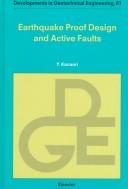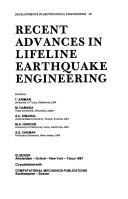| Listing 1 - 10 of 59 | << page >> |
Sort by
|
Book
ISBN: 1784662046 9781784662042 1784662038 9781784662035 Year: 2017 Publisher: Southampton WIT Press
Abstract | Keywords | Export | Availability | Bookmark
 Loading...
Loading...Choose an application
- Reference Manager
- EndNote
- RefWorks (Direct export to RefWorks)
Book
ISBN: 1283433141 9786613433145 1848163991 9781848163997 9781848163973 1848163975 9781848163980 1848163983 9781283433143 6613433144 Year: 2011 Publisher: London Imperial College Press
Abstract | Keywords | Export | Availability | Bookmark
 Loading...
Loading...Choose an application
- Reference Manager
- EndNote
- RefWorks (Direct export to RefWorks)
Introduction to Computational Earthquake Engineering covers solid continuum mechanics, finite element method and stochastic modeling comprehensively, with the second and third chapters explaining the numerical simulation of strong ground motion and faulting, respectively. Stochastic modeling is used for uncertain underground structures, and advanced analytical methods for linear and non-linear stochastic models are presented. The verification of these methods by comparing the simulation results with observed data is then presented, and examples of numerical simulations which apply these method
Book
ISBN: 1773615793 9781773615790 Year: 2019 Publisher: Ashland
Abstract | Keywords | Export | Availability | Bookmark
 Loading...
Loading...Choose an application
- Reference Manager
- EndNote
- RefWorks (Direct export to RefWorks)
Seismology, Earthquake Engineering and Structural Engineering examines various dimensions of seismology, and earthquake engineering. It includes the meaning of seismology, a description about earthquake and various structural engineering tools and applications required to deal with earthquake. Provide the reader with the insights into the development of various structural engineering products to get rid of after-effects of earthquakes and help people overcome the vulnerable effect of it.
Seismology. --- Earthquake engineering. --- Structural engineering.
Book
ISBN: 1784660140 9781784660147 9781784660130 Year: 2015 Publisher: Southampton
Abstract | Keywords | Export | Availability | Bookmark
 Loading...
Loading...Choose an application
- Reference Manager
- EndNote
- RefWorks (Direct export to RefWorks)
Over the life of a structure, the smaller but more frequent earthquakes contribute more to the cumulative damage than the larger earthquakes on which structural design is traditionally based. This is a quantitative argument in favour of designing structures beyond what the codes require for life-safety.This book presents a computational method to evaluate the damage sustained by a building over its lifetime in a seismic environment. The ability to estimate future damage is relevant to a pair of current trends in earthquake engineering: a growing interest for preventing damage on top of protect
Earthquake engineering --- Examinations --- Data processing.
Periodical
ISSN: 1993503X 16713664
Abstract | Keywords | Export | Availability | Bookmark
 Loading...
Loading...Choose an application
- Reference Manager
- EndNote
- RefWorks (Direct export to RefWorks)
Book
ISBN: 9783031151040 Year: 2022 Publisher: Cham Springer International Publishing :Imprint: Springer
Abstract | Keywords | Export | Availability | Bookmark
 Loading...
Loading...Choose an application
- Reference Manager
- EndNote
- RefWorks (Direct export to RefWorks)
Earthquake engineering --- Seismology --- Seismography --- Geophysics --- Earthquakes

ISBN: 9780444825629 0444825622 9780080530666 0080530664 1281759899 9781281759894 9786611759896 6611759891 Year: 1997 Publisher: Amsterdam ; New York : Elsevier,
Abstract | Keywords | Export | Availability | Bookmark
 Loading...
Loading...Choose an application
- Reference Manager
- EndNote
- RefWorks (Direct export to RefWorks)
On 17th January 1995 an inland earthquake of 7.2 magnitude occurred under Kobe city in central Japan. More than 5,500 people lost their lives. There was immense and serious damage to buildings. Researchers and engineers were shocked and astonished by the extent of the devastation and loss of life. Ground motions, generated by the event were far greater than the seismic standard for earthquake-proof designs in Japan. Recent academic progress in the fields of geology and geophysics, which would help to reduce the severity of seismic disasters, has not been sufficiently applied to the developme
Earthquake resistant design. --- Faults (Geology) --- Earthquake engineering.

ISBN: 044498934X 9780444989345 9780444596970 0444596976 0905451937 9780905451930 0931215714 9780931215711 Year: 1987 Volume: 49 Publisher: Amsterdam ; New York : Southampton, United Kingdom ; Boston : New York, New York : Elsevier ; Computational Mechanics Publications ; Distributors for the U.S. and Canada, Elsevier Science Pub. Co.,
Abstract | Keywords | Export | Availability | Bookmark
 Loading...
Loading...Choose an application
- Reference Manager
- EndNote
- RefWorks (Direct export to RefWorks)
Lifeline earthquake engineering is the application of all relevant knowledge and skill to provide economically feasible engineering safeguards for critical systems such as energy, transportation, water, power, communications, etc. Natural gas and oil pipelines, water and sewage lines, oil and gas storage facilities, tunnels, power, voice and data communication lines and equipment are some of the recognized examples in this relatively new area of interest which has attracted an ever-increasing number of researchers in the past few years.This volume contains most of the papers on lifeli
Lifeline earthquake engineering --- Public utilities --- Earthquake effects
Periodical
ISSN: 15731456 1570761X
Abstract | Keywords | Export | Availability | Bookmark
 Loading...
Loading...Choose an application
- Reference Manager
- EndNote
- RefWorks (Direct export to RefWorks)
Earthquake engineering --- Earthquake engineering. --- Civil engineering --- Engineering --- Engineering geology --- Shear walls
Book
ISBN: 1523122722 3035733015 9783035733013 9781523122721 9783035713015 Year: 2018 Publisher: Zurich, Switzerland
Abstract | Keywords | Export | Availability | Bookmark
 Loading...
Loading...Choose an application
- Reference Manager
- EndNote
- RefWorks (Direct export to RefWorks)
Building, Iron and steel --- Steel, Structural --- Earthquake engineering
| Listing 1 - 10 of 59 | << page >> |
Sort by
|

 Search
Search Feedback
Feedback About UniCat
About UniCat  Help
Help News
News